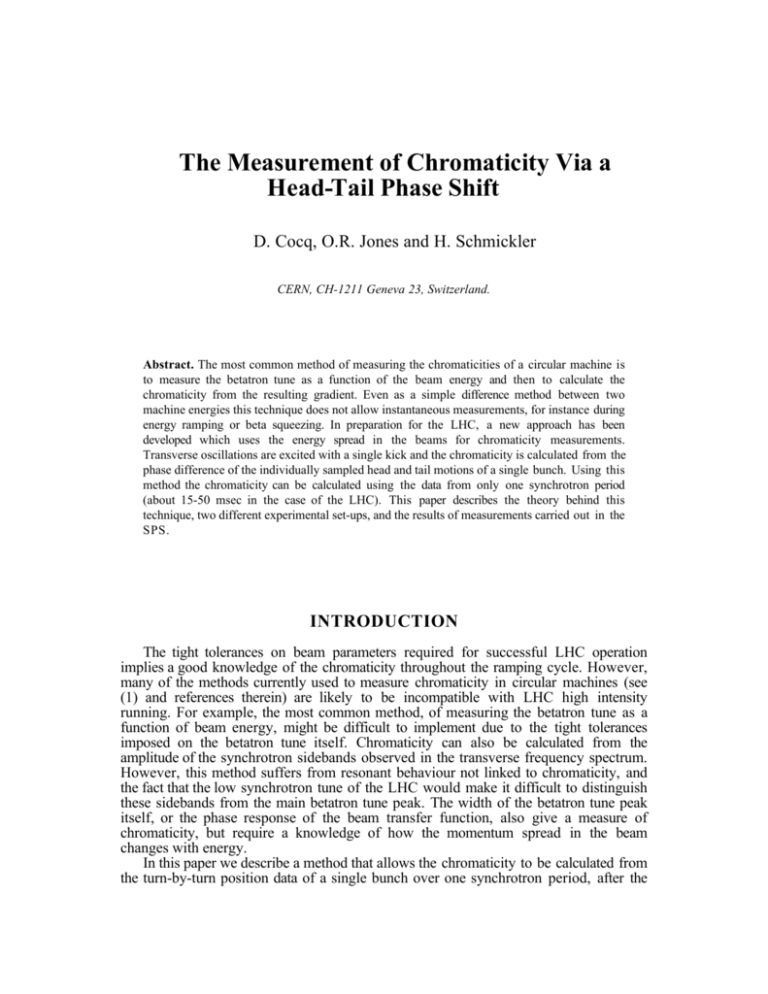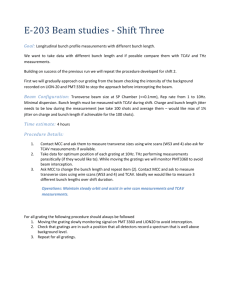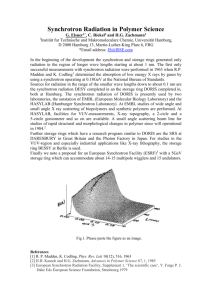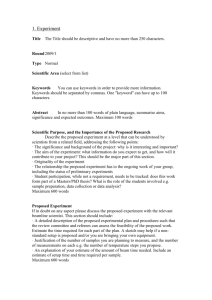The Measurement of Chromaticity Via a Head-Tail Phase Shift
advertisement

The Measurement of Chromaticity Via a Head-Tail Phase Shift D. Cocq, O.R. Jones and H. Schmickler CERN, CH-1211 Geneva 23, Switzerland. Abstract. The most common method of measuring the chromaticities of a circular machine is to measure the betatron tune as a function of the beam energy and then to calculate the chromaticity from the resulting gradient. Even as a simple difference method between two machine energies this technique does not allow instantaneous measurements, for instance during energy ramping or beta squeezing. In preparation for the LHC, a new approach has been developed which uses the energy spread in the beams for chromaticity measurements. Transverse oscillations are excited with a single kick and the chromaticity is calculated from the phase difference of the individually sampled head and tail motions of a single bunch. Using this method the chromaticity can be calculated using the data from only one synchrotron period (about 15-50 msec in the case of the LHC). This paper describes the theory behind this technique, two different experimental set-ups, and the results of measurements carried out in the SPS. INTRODUCTION The tight tolerances on beam parameters required for successful LHC operation implies a good knowledge of the chromaticity throughout the ramping cycle. However, many of the methods currently used to measure chromaticity in circular machines (see (1) and references therein) are likely to be incompatible with LHC high intensity running. For example, the most common method, of measuring the betatron tune as a function of beam energy, might be difficult to implement due to the tight tolerances imposed on the betatron tune itself. Chromaticity can also be calculated from the amplitude of the synchrotron sidebands observed in the transverse frequency spectrum. However, this method suffers from resonant behaviour not linked to chromaticity, and the fact that the low synchrotron tune of the LHC would make it difficult to distinguish these sidebands from the main betatron tune peak. The width of the betatron tune peak itself, or the phase response of the beam transfer function, also give a measure of chromaticity, but require a knowledge of how the momentum spread in the beam changes with energy. In this paper we describe a method that allows the chromaticity to be calculated from the turn-by-turn position data of a single bunch over one synchrotron period, after the application of a transverse kick. It will be shown that the chromaticity can be obtained by determining the evolution of the phase difference between two longitudinal positions within the bunch. This technique does not rely on an accurate knowledge of the fractional part of the betatron tune and, for a machine operating well above transition, the calculated chromaticity is virtually independent of beam energy. SINGLE PARTICLE DYNAMICS IN A BUNCHED BEAM The longitudinal motion of a particle within a bunch can be described in terms of the synchrotron frequency and the difference between the particle’s momentum and the nominal momentum. This can be expressed as τ = τˆ cos(ω st + φ ) (1) where τ is the variation with time t of the particle from the bunch center, ωs is the angular synchrotron frequency and φ is the initial longitudinal phase of the particle (Fig. 1). FIGURE 1. Longitudinal phase-space. During this longitudinal motion the particle also undergoes transverse motion, which can be described by the change in the betatron phase, θ(t), along the synchrotron orbit. The rate of change of this betatron phase is given by θ̇ = Qω = (Q0 + ∆Q)(ω0 + ∆ω) (2) where Q0 is the nominal transverse tune, ∆Q is the change in tune due to the momentum spread, ω0 is the nominal angular revolution frequency and ∆ω is the change in this frequency due to the momentum spread. Now ∆ω ∆p = −η , p ω0 ∆Q ∆p ∆T ∆ω = ξ , and τ˙ = − = Q0 p Trev ω0 (3) where: ξ = η = Trev = Hence ∆Q = − relative chromaticity (Q′/Q0 where Q′ is the chromaticity) 1/(γ)2 - α (where α = 1/(γtr)2 is the momentum compaction factor) revolution period ξ Q 0τ& η and ∆ω = ω 0τ& , which on substitution into (2) gives ξ ξ ξ θ˙ = Q0 − Q0τ˙ (ω 0 + ω 0τ˙ ) = Q0ω 0 1 − τ˙ (1 + τ˙ ) ≈ Q0ω 0 1 + τ˙ 1 − η η η (3) ξ and is η known as the chromatic frequency. Since τ is usually much smaller than t, one can write: Integrating one obtains θ (t ) ≈ Q0ω 0 (t + τ ) − ω ξτ + θ 0 where ω ξ = Q0ω 0 θ (t ) ≈ Q0ω 0t − ω ξτˆ cos(ω s t + φ ) + θ 0 (4) where θ0 is the initial betatron phase of the particle. If we assume that the displacement due to the kick is much larger than the betatron oscillations performed by the particles in the unperturbed bunch, then the initial betatron phase can be set such that all the particles have the same initial position in the transverse plane; i.e. at t = 0 a particle with a longitudinal position described by τˆ i and θ i will have an initial betatron phase given by θ 0 = ω ξτˆi cos(φi ) (5) Hence the position of a particle in the bunch, yi, at any time t is given by yi(t) = Acos(θ(t)) (6) where A is the maximum amplitude of the betatron motion. Extracting the Chromaticity by Considering Head-Tail Evolution Consider a system where the particles are distributed along a single synchrotron orbit, and where the particle position is measured as a function of time at the tail of the bunch (point T in Fig. 1). The initial synchrotron phase, φi, of the particle at the tail after a given time t is given by φi = -ωst, and therefore the corresponding initial betatron phase, (θ0)i , can be written as (θ 0 )i= ωξ τˆi cos(− ωst) . Hence the transverse amplitude at the tail evolves as yT (t ) = A cos(Q0ω 0 t − ω ξτˆT cos(ω s t + φ ) + ω ξτˆT cos( −ω s t )) = A cos(Q0ω 0 t + ω ξτˆT (cos( −ω s t ) − 1)) (7) Measurements are carried out turn by turn, which corresponds to time steps of t = 2πn ω 0 , where n is the turn number. Hence the signal at the tail of the bunch for a given turn, n, can be written as ( ) yT (n) = A cos 2πnQ0 + ω ξτˆT (cos(2πnQs ) − 1) (8) where Qs is the synchrotron tune, with ωs = Qsω0. A similar expression can also be derived for the head of the bunch ( ) yH (n) = A cos 2πnQ0 − ω ξτˆ H (cos(2πnQs ) − 1) (9) The phase difference between head and tail as a function of turn number is therefore given by ∆ψ (n) = − ω ξ (τˆ H + τˆT )(cos(2πnQs ) − 1) (10) This equation is a maximum when nQs = 1 2 , i.e. after half a synchrotron period, giving ∆ψ MAX = − 2ω ξ (τˆ H + τˆT ) = − 2ω ξ ∆τ (11) The chromaticity can therefore be written as ξ= −η ∆ψ (n) Q0 ω 0 ∆τ (cos(2πnQs ) − 1) or ξ = η ∆ψ MAX 2Q0 ω 0 ∆τ (12) Since the revolution frequency and total tune of the machine are known to a high degree of accuracy, and if one considers a machine operating well above transition, the chromaticity will depend only on the maximum phase difference attained between two regions of the same bunch, separated longitudinally by a known time. EXPERIMENTAL SET-UP In order to illustrate the principle of this technique, head-tail phase measurements were performed on proton bunches in the SPS. Each acquisition involved the measurement of 100 to 200 turns of data (around one SPS synchrotron period) after the application of a single transverse kick. An exponential transverse coupler was used to provide the transverse position data as a function of the longitudinal position within the bunch. In the first experiments the signal from the coupler was analyzed using two sample-and-hold amplifiers. This then provided information on the transverse position of two specific locations within the bunch (one positioned near the head of the bunch and the other, near the tail). Later experiments relied on a digital oscilloscope with fastframe capabilities, from which a single trace gave transverse position information for the whole bunch as a function of longitudinal position. Head-Tail Phase Measurements using Head and Tail Samplers The experiments using the head and tail samplers were performed on the Machine Development (MD) cycle of the SPS, which provided a single bunch of ~2×1010 protons at an energy of 26 GeV and with a length of ~3.8 ns. Differenti ate Σ Sample a nd Hold (Head) Obta in Tr igger Head si gnal ou t Wideband Transverse Coupl er BPW 31798 h (oriz onta l) BPWA 31931 (verti cal) ∆ Dela y Li ne FIGURE 2. 1ns Del ay Sample a nd Hold (Tai l) Tail si gnal ou t Sampler acquisition schematic. Figure 2 shows a schematic of the acquisition system. The coupler sum signal was used to auto-trigger two Avtech AVS-105 variable gate width sample-and-hold amplifiers. The trigger of one sampler was delayed by ~1 ns with respect to that of the other, to allow the transverse bunch position to be sampled at two longitudinal positions separated in time by this delay. Each sampler had a gate width of ~200 ps and provided an output pulse of 500 ns duration with an amplitude proportional to the input amplitude. The output from both samplers was stored on a turn-by-turn basis on two channels of a Le-Croy 9354, 500 MHz, digital oscilloscope. Each acquisition, which consisted of around 200 turns of information, could then be transferred to a computer for analysis. Head-Tail Phase Measurements using a Tektronix 784A Oscilloscope By using a Tektronix 784A digital oscilloscope, with an analog bandwidth of 1 GHz and a maximum sampling rate of 4 GS/s, the complete coupler signal of a single bunch could be reconstructed. Additionally, a fast-frame acquisition setting meant that the signal could be recorded on consecutive SPS machine turns. This removed the necessity of having individual sample-and-hold amplifiers. When using the Tektronix 784A, the turn-by-turn acquisition was triggered directly from the SPS rf system. Experiments using this acquisition system were again performed on the SPS MD cycle, this time with 20 bunches in the machine, each bunch having the same characteristics as described previously. The internal memory of the oscilloscope provided enough space to record up to 160 turns of data, which could be transferred directly to a computer for further analysis. RESULTS The raw data obtained from the head-tail samplers give graphs such as those of Figure 3(a & b). Here one sees the variation in the transverse position of two segments of the bunch separated by ~1ns, after applying a kick to the beam. FIGURE 3(a). Head sampler signal. FIGURE 3(b). Tail sampler signal. In order to calculate the phase relationship between the head and tail signals, a sweeping harmonic analysis was performed. This involved working out the phase by harmonic analysis for each turn, using the current data point and 10 points on either side. Since the same calculation was performed on both signals, the phase difference for each turn could be found by simply subtracting the individual phases. The results of such a harmonic analysis sweep is shown in Figure 4. Here one clearly sees the dephasing and re-phasing of the two positions within the bunch during one synchrotron period, with the maximum phase difference occurring after half a synchrotron period. Once the phase difference evolution is known, it is possible to calculate the chromaticity, using Equation (12), on a turn-by turn basis. The result of such a calculation is shown in Figure 5. Due to the cosine term in the denominator of Equation (12) the error in the calculation of the chromaticity is very large at the start and end of the synchrotron period, while it is at a minimum at half the synchrotron period. In this particular case, there was sufficient signal to enable the chromaticity to be calculated again during the second synchrotron period. The average value of the chromaticity in this particular case, indicated by the dashed horizontal line, was calculated from the 40 turns around the center of both synchrotron periods. A typical ‘mountain range’ display result obtained by capturing the coupler signal using the Tektronix 784A can be seen in Figure 6(a). The signal was sampled at 4 Gs/s and automatically interpolated to give output data points every 20 ps. The second, smaller, out-of-phase oscillation seen in the figure is the reflection of the main signal from the exponential coupler. In order to determine the chromaticity, we require knowledge of the phase difference evolution of two separate locations within the bunch. Hence, two cuts in the longitudinal plane were performed to obtain the evolution of two points located to either side of the bunch center (Fig. 6(b)). By performing a sweeping harmonic analysis on these two data sets, as previously described, the phase difference evolution and, hence, the chromaticity could be extracted on a turn-by-turn basis. FIGURE 4. Phase difference evolution. FIGURE 5. Turn-by-turn chromaticity. This phase difference evolution for two consecutive acquisitions is plotted in Figure 7. The measurements were found to be reproducible, with the calculated value for the chromaticity in agreement to within 10%. Finally, Figure 8 shows the vertical chromaticity, calculated by the head-tail phase difference, as a function of the vertical chromaticity machine trim. The results are what one would expect, with a linear relationship found between the trim and chromaticity. FIGURE 6(a). Tektronix 784A output. FIGURE 6(b). Extracted head and tail signals. FIGURE 7. The time evolution of ∆ψ. FIGURE 8. Variation of ξ with machine trim. CONCLUSION It has been demonstrated that the chromaticity of a circular machine can be calculated from the evolution of the phase difference between the head and tail of a single bunch after the application of a transverse kick. Using this technique, a measure of chromaticity can be obtained from a single synchrotron period. The sensitivity of the head-tail method relies on the fact that a sufficiently large phase difference can be achieved between the head and tail signals. Since, for a given chromaticity, this phase difference is proportional to the head-tail separation, the sensitivity is ultimately governed by the bunch length. Hence, this technique should work in proton machines where the bunch lengths are relatively large, but may prove difficult to implement in lepton machines, where the small bunch lengths imply a very short maximum head-tail separation. Further studies are planned to investigate the effect of higher order fields, such as octupolar fields, which will be of consequence for the LHC, and also to determine the signal-to-noise ratio required for accurate measurements. This latter point will ultimately determine the emittance blow-up caused by repeated measurements, which is again of great importance for any proton machines. REFERENCES [1] Schmickler, H., “Diagnostics and Control of the Time Evolution of Beam Parameters” (CERN-SL-97-68), presented at the 3rd European Workshop on Beam diagnostics and Instrumentation for Particle Accelerators (DIPAC 97), Frascati, Italy, October 1997.





![Chapter 12 2 [MS Word Document, 283.0 KB]](http://s3.studylib.net/store/data/007814251_2-e4ef09d20f4a8eef2d170e162941f5cc-300x300.png)
